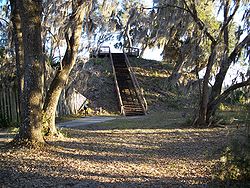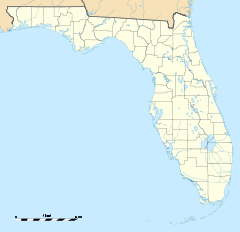- Crystal River Archaeological State Park
-
Crystal River Indian Mounds
 Temple mound
Temple moundLocation: Crystal River, Florida Coordinates: 28°55′01″N 82°36′33″W / 28.91694°N 82.60917°WCoordinates: 28°55′01″N 82°36′33″W / 28.91694°N 82.60917°W Area: 61 acres (250,000 m2) Visitation: 21,000 Governing body: Florida Department of Environmental Protection NRHP Reference#: 70000178[1] Significant dates Added to NRHP: September 29, 1970 Designated NHL: June 21, 1990[2] Crystal River State Archaeological Site is a 61-acre (250,000 m2) Florida State Park located on the Crystal River and within the Crystal River Preserve State Park. The park is located two miles (3 km) northwest of the city of Crystal River, on Museum Point off US 19/98.
Under the title of Crystal River Indian Mounds, it is also a U.S. National Historic Landmark (designated as such on September 29, 1970).
Contents
History
The park contains a six-mound complex, built by pre-Columbian mound builders, that is considered one of the longest continually occupied sites in Florida, believed to have been occupied for 1,600 years. Native Americans traveled long distances to the complex to bury their dead and to engage in trading activities. An estimated 7,500 people may have visited the complex annually when it was occupied. The complex contains burial mounds, temple/platform mounds, a plaza area, and a midden. Over a period of approximately 1,900 years, beginning about 500 BC, the Native Americans at the Crystal River Site threw away great quantities of materials that would form the middens that adorn the site. This "midden material" contained various kinds of woodland animal bones, fish bones, turtle shells, broken pottery, broken hand tools and arrowheads. By the time of abandonment, the midden area had reached 1,300 feet in length, 100 feet in width, 7 feet in depth, and was formed into a crescent shape[3]. Two large platform mounds are believed to have been used primarily for ceremonial purposes. A half-mile paved loop trail passes by each mound, with signs interpreting the mounds. A 55 step observation deck atop the park's largest mound, Temple Mound, provides a panoramic view of the area. The park contains coastal marsh and is part of the Great Florida Birding Trail.
The park is also home to a limestone slab, possibly a "stele", on which is a crudely carved human face and torso.[4] There has been debate as to how strongly this inscribed stone slab was influenced by the monumental stelae of Mesoamerica.[5] Although there may be some evidence for contact between the Huastec Culture of the Mexican Gulf Coast and the American Southeast[6] , those claims which suggest the most direct connections are probably unfounded. The slab is today housed on the site within a metal cage.[7]
Recreational activities
Activities include salt and fresh water fishing, picnicing, bird watching and a boat tour of Crystal River. Amenities include a small picnic area. The visitor center/museum features an open captioned video about the tribes that once lived in the area, and houses a collection of artifacts from the site, including arrowheads, pottery, jewelry, stone and bone tools.
Hours
The museum is open from 9:00 a.m. to 5:00 p.m. daily. Florida state parks are open between 8 a.m. and sundown every day of the year (including holidays).
References
- ^ "National Register of Historical Places - Florida (FL), Citrus County". National Register of Historic Places. National Park Service. 2007-02-25. http://www.nationalregisterofhistoricplaces.com/FL/Citrus/state.html.
- ^ Crystal River Site at National Historic Landmarks Program
- ^ crytal river state parks
- ^ Milanich, Jerald T. (1994). Archaeology of Precolumbian Florida. Gainesville, Florida: University Press of Florida. pp. 217. ISBN 0-8130-1273-2.
- ^ Milanich, Jerald T. (1999). Famous Florida Sites: Mount Royal and Crystal River. Gainesville, Florida: University Press of Florida. pp. 22–23. ISBN 0-8130-1694-0.
- ^ Bullen, Ripley P. (1966). "Stelae at the Crystal River Site, Florida". American Antiquity, 31(6):865
- ^ Snow, Dean R. (2010). Archaeology of Native North America. New York, New York: Prentice Hall. ISBN 0-13-615686-X.
See also
- Mound
- Mound builder (people)
- Earthwork (archaeology)
External links
- Citrus County listings at Florida's Office of Cultural and Historical Programs
- Crystal River Archaeological State Park at Florida State Parks
- Crystal River State Archaeological Site at Absolutely Florida
- Crystal River State Archeological Site at The National Park Service - Links to the Past
- Crystal River State Archaeological Site pictures at Florida Center for Instructional Technology
- Famous Florida Sites: Mount Royal and Crystal River, edited with an introduction by Jerald T. Milanich (ISBN 0-8130-1694-0), Gainesville: University Press of Florida (1999).
Protected Areas of Florida Federal Archie Carr • Arthur R. Marshall Loxahatchee • Caloosahatchee • Cedar Keys • Chassahowitzka • Crocodile Lake • Crystal River • Egmont Key • Florida Panther • Great White Heron • Hobe Sound • Island Bay • J.N. 'Ding' Darling • Key West • Lake Wales Ridge • Lake Woodruff • Lower Suwannee • Matlacha Pass • Merritt Island • National Key Deer • Okefenokee • Passage Key • Pelican Island • Pine Island • Pinellas • St. Johns • St. Marks • St. Vincent • Ten Thousand IslandsFlorida Keys National Marine Sanctuary • Big Cypress National Preserve • Timucuan Ecological and Historic Preserve •
Canaveral National Seashore • Gulf Islands National Seashore •
Apalachicola National Estuarine Research Reserve • Guana Tolomato Matanzas National Estuarine Research Reserve • Rookery Bay National Estuarine Research ReserveState Amelia Island • Anastasia • Avalon • Bahia Honda • Bald Point • Big Lagoon • Big Talbot Island • Bill Baggs Cape Florida • Bulow Creek • Caladesi Island • Camp Helen • Cayo Costa • Collier-Seminole • Curry Hammock • Delnor-Wiggins Pass • Devil's Millhopper • Don Pedro Island • Eden Gardens • Egmont Key • Falling Waters • Faver-Dykes • Florida Caverns • Fort Clinch • Fort Cooper • Fort George Island • Fort Pierce Inlet • Fred Gannon Rocky Bayou • Gasparilla Island • George Crady Bridge Fishing Pier • Highlands Hammock • Hontoon Island • Hugh Taylor Birch • John D. MacArthur Beach • John Pennekamp Coral Reef • John U. Lloyd Beach • Jonathan Dickinson • Little Talbot Island • Long Key • Lovers Key / Carl E. Johnson • Mike Roess Gold Head Branch • Navarre Beach • North Peninsula • O'Leno • Oscar Scherer • Ravine Gardens • River Bluff Picnic Site • Sebastian Inlet • Skyway Fishing Pier • St. George Island • St. Joseph Peninsula • Stephen Foster Folk Culture Center • Stump Pass Beach • Tomoka • Torreya • Windley Key Fossil Reef
Deer Lake • Lake Griffin • Lake June in Winter Scrub • Lake Kissimmee • Lake Louisa • Lake Manatee • Lake Talquin • Alafia River • Blackwater River • Econfina River • Guana River • Hillsborough River • Little Manatee River • Myakka River • Ochlockonee River • Silver River • Suwannee River • Blue Spring • De Leon Springs • Edward Ball Wakulla Springs • Fanning Springs • Homosassa Springs Wildlife • Ichetucknee Springs • Lafayette Blue Springs • Madison Blue Springs • Manatee Springs • Rainbow Springs • Troy Springs • Weeki Wachee Springs • Wekiwa Springs • Werner-Boyce Salt Springs • Wes Skiles Peacock Springs
Cedar Key Museum • Constitution Convention Museum • Forest Capital Museum • John Gorrie State Museum • Ybor City Museum • The Barnacle • Bulow Plantation Ruins • Dade Battlefield • DeSoto Site • Dudley Farm • Fort Foster • Fort Mose • Fort Zachary Taylor • Gamble Plantation • Indian Key • Koreshan • Marjorie Kinnan Rawlings Homestead • Natural Bridge Battlefield • Olustee Battlefield • Orman House • Paynes Creek • San Marcos de Apalache • Yellow Bluff Fort • Yulee Sugar Mill Ruins • Crystal River • Lake Jackson Mounds • Letchworth Mounds • Madira Bickel Mound • Mound Key • San Pedro Underwater
Anclote Key • Cedar Key Scrub • Charlotte Harbor • Crystal River • Estero Bay • Fakahatchee Strand • Grassy Lake • Hal Scott • Kissimmee Prairie • Lower Wekiva River • Paynes Prairie • Pumpkin Hill Creek • River Rise • Rock Springs Run • San Felasco Hammock • Savannas • Seabranch • St. Lucie Inlet • St. Sebastian River • Tarkiln Bayou • Topsail Hill • Tosohatchee • Waccasassa Bay • Yellow River Marsh
Belmore • Big Shoals Public Lands • Blackwater River • Carl Duval Moore • Cary • Cottage Hill • Deep Creek • Etoniah Creek • Four Creeks • Goethe • Holopaw • Indian Lake • Jennings • John Bethea • Lake George • Lake Talquin • Lake Wales Ridge • Little Big Econ • Matanzas • Myakka • Okaloacoochee Slough • Picayune Strand • Pine Log • Point Washington • Ralph E. Simmons Memorial • Ross Prairie • Seminole • Tate's Hell • Tiger Bay • Twin Rivers • Wakulla • Watson Island • Welaka • Withlacoochee
Florida Department of Environmental Protection U.S. National Register of Historic Places in Florida Lists by county Alachua • Baker • Bay • Bradford • Brevard • Broward • Calhoun • Charlotte • Citrus • Clay • Collier • Columbia • DeSoto • Dixie • Duval • Escambia • Flagler • Franklin • Gadsden • Gilchrist • Glades • Gulf • Hamilton • Hardee • Hendry • Hernando • Highlands • Hillsborough • Holmes • Indian River • Jackson • Jefferson • Lafayette • Lake • Lee • Leon • Levy • Liberty • Madison • Manatee • Marion • Martin • Miami-Dade • Monroe • Nassau • Okaloosa • Okeechobee • Orange • Osceola • Palm Beach • Pasco • Pinellas • Polk • Putnam • Santa Rosa • Sarasota • Seminole • St. Johns • St. Lucie • Sumter • Suwannee • Taylor • Union • Volusia • Wakulla • Walton • Washington

Lists by city Other lists Keeper of the Register • History of the National Register of Historic Places • Property types • Historic district • Contributing property Categories:- Mounds in the United States
- Native American history of Florida
- Native American museums in Florida
- Museums in Citrus County, Florida
- Archaeology museums in Florida
- Archaeological sites in Florida
- National Historic Landmarks in Florida
- Historic Florida architecture 1989 AIA survey listings in Citrus County
- Florida state parks
- Parks in Citrus County, Florida
- Protected areas established in 1970
- Florida state park stubs
Wikimedia Foundation. 2010.


